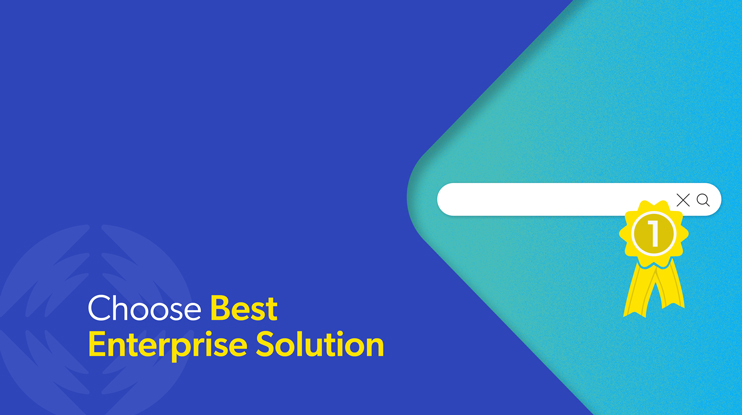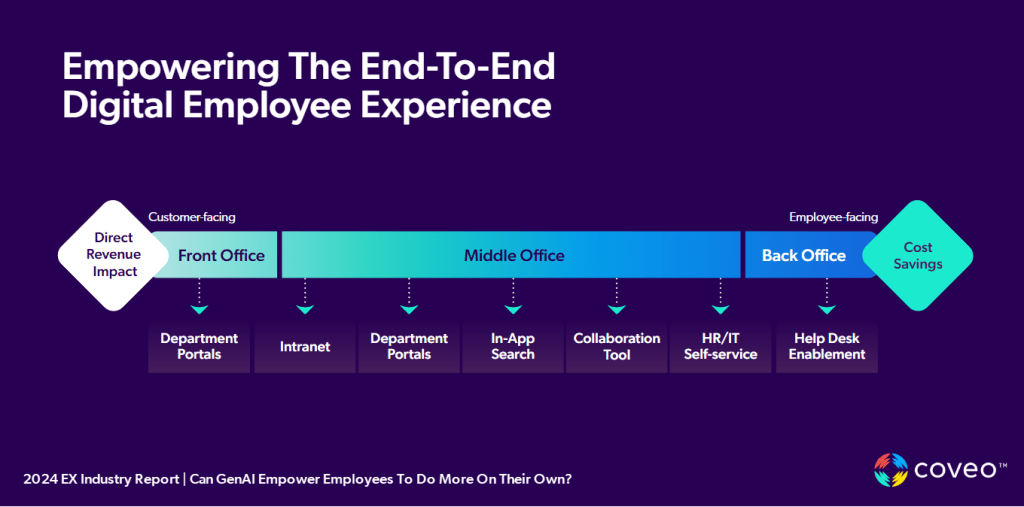Welcome to the experience expectation gap. Across generations, employees are struggling to find critical data. Information could be anywhere: Slack; a content management system (CMS) like Google Drive; a customer relationship management (CRM) system like Salesforce; or on an employee’s own device.
As a result, employees don’t know where to look, with 89% of employees searching one to six data sources to do their job. When they do find what they need, employees aren’t sure if what they’ve found is accurate; 45% say what they do find is irrelevant. For nearly 90% of respondents to a recent Coveo Workplace Relevance report, this inability to find information gives way to considerable frustration.
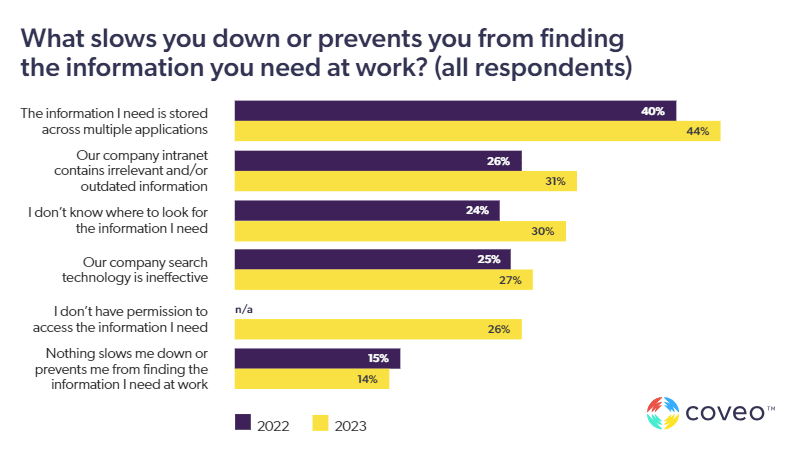
As a result, employee experience continues to suffer, and with it service quality and customer experience. And now that workplaces have become more distributed than ever — in terms of both employees and information — proper enterprise search engines have never been so critical.
Choosing an enterprise search solution, however, is a big decision. Besides robust search capabilities, remaining agile and adaptable to change has never been more important for the enterprise. So it’s crucial to consider not only what best meets the needs of your business today, but what will continue to work for your employees as your team grows and accumulates more knowledge.
Here are seven considerations when selecting the best enterprise search software for your digital workplace.
1. Ability to Securely Connect Content Sources
Enterprises with 2,000+ employees now use an average of 175 SaaS applications. The 2024 SaaS Management Index revealed an average of $18M in annual license waste. At the very least, your enterprise search solution should be able to index all of these data sources, without contributing to growing SaaS-related security concerns. According to the Netskope Cloud and Threat Report 2024, 50% of HTTP and HTTPS malware downloads originated from SaaS apps over the past year.
The first step in assessing an enterprise search solution is to establish its capability to connect to each content source at your company, including:
- Out-of-the-box connectors that can quickly index content from Sharepoint, Google Drive, and more
- Flexible API-based connectivity for proprietary platforms and less common (or more complex) workplace software
- A crawling module that allows you to pull on-premises content into the cloud and make it searchable from anywhere
Larger enterprises are unlikely to find an enterprise search solution that can do everything they need out of the box. But a solution with flexible connectors that offers “set-and-forget” machine learning models will get you up and running faster — and provide more scalability.
Beware of enterprise search solutions that simply provide a framework for your developers to build upon. While suitable for smaller outfits, they are less scalable for larger enterprises and require heavy lift from your development team.
How Much Does Connectivity Matter?
The ability to index content from all of your company’s data repositories and applications is the bedrock of your workplace search system. It’s critical to knowledge management strategy, too. Still, it’s important to remain flexible to accommodate tools and data sources that you might introduce in the future.
Compromising on connectivity is unwise, whatever size your organization is at now. Today, 99% of companies struggle to deliver relevant search results to their users. A lack of connectivity is a primary reason why.
2. AI-Powered Enterprise Search Relevance
Indexing all of your enterprise content is the most basic requirement of an effective enterprise search solution. To provide the best possible knowledge discovery experience for your employees, your solution has to analyze and understand each file within the index, and stitch together insights from every interaction to establish its relevance.
This kind of scalable search relevance is only possible with artificial intelligence (AI).
Some enterprise search solutions allow people to “verify” the quality of search results manually to help the algorithm learn. But when you’re indexing thousands or even millions of new documents every year, this effort isn’t sustainable.
Look for a solution that can establish relevance automatically by considering an employee’s location, role, and interactions, in addition to the context gathered about each indexed document. This way, you provide a better search experience with every interaction, without the burdens of manual curation and constant maintenance.
Employees want to cut through the noise to find role-specific knowledge that helps them grow and accomplish more. If they’re new to your company, they want to see onboarding content that makes them feel supported. They certainly don’t want to see HR policies that don’t apply to their location, or training content that’s only relevant to other teams.
Relevant Reading: Understanding Relevance Maturity in Service & Workplace
How Critical is AI to Exceptional Search Experiences?
Personalizing the employee experience is no longer a “nice to have”—it’s expected by your workforce. So if it seems like overkill, think again.
Irrelevant or out-of-date information is usually to blame for a poorly-adopted company intranet, for example. A lack of personalization can severely degrade employee and customer experience. Solving these problems in the long term requires AI.
With the vast amount of information spread across the digital workplace, there’s no other way to provide the personalized experience each user now expects from search.
3. Unified AI Search with Machine Learning
Enterprise search solutions vary in the way that they gather data and make it searchable.
Federated search, using search-time merging (or query-time merging), looks within each separate enterprise search using a single search query. This system pulls search results from each data source successfully, and can be quite fast to implement.
However, because institutional knowledge continues to exist within separate buckets under this system, search is limited to establishing relationships between different pieces of content. These relationships drive the level of relevance that the solution can deliver to your employees, so it’s an important drawback.
Unified search, paired with machine learning (ML), brings all of your unstructured and structured data into a single AI search engine, and continuously makes connections between everything in that index, regardless of source.
For reference, Coveo uses a unified index with AI capabilities and applied machine learning. The combination opens the door to a variety of enterprise use cases.
Relevant Reading: 3 Unified Search Examples: How Relevance Takes Your Business to the Next Level
How Important is Unified Search?
Simple federated search can work adequately for smaller organizations with fewer data sources.
But for organizations with a high document count, and many disparate systems, unified search with machine learning adds enormous value. That’s because it can stitch together insights from interactions with content across your entire knowledge management ecosystem — automatically — even as you continue to add new content and data sources.
The result is greater search relevance, without costly upkeep. That’s a big win for both your employees, and your IT budget. After implementing Coveo enterprise search, for example, Xero increased self-service resolution by 20% — in six weeks.
What About Generative AI?
If your enterprise search solution doesn’t have an answer to the generative AI question, they’re behind the ball. Yet offering generative AI alone is but one step in the right direction. Implementing this game changing technology requires concrete answers to a few important questions:
- Is your enterprise ready for generative AI? 60% of workplaces don’t have an IT/HR/Legal GenAI policy (Coveo 2024 EX Industry Report)
- How will you use generative AI in practice?
- Should you really build it yourself?
- Is the technology reliable and secure?
- Do your teams have the right skills to maximize generative AI?
4. Centralized Knowledge Within Your Existing Platforms
The sheer number of workplace apps used by your employees every day brings with them a plethora of distractions. Our own research has revealed that employees spend approximately three hours in an average workday searching for information, often jumping between various systems to find what they need (Coveo Workplace Relevance Report 2023).
The answer is to make all of your enterprise knowledge discoverable from a single, unified search interface — and to make that search interface accessible within your existing intranet or self-service portals. Your agent interface, in particular, is a critical touchpoint for personalized, contextually relevant recommendations made possible by centralized knowledge.
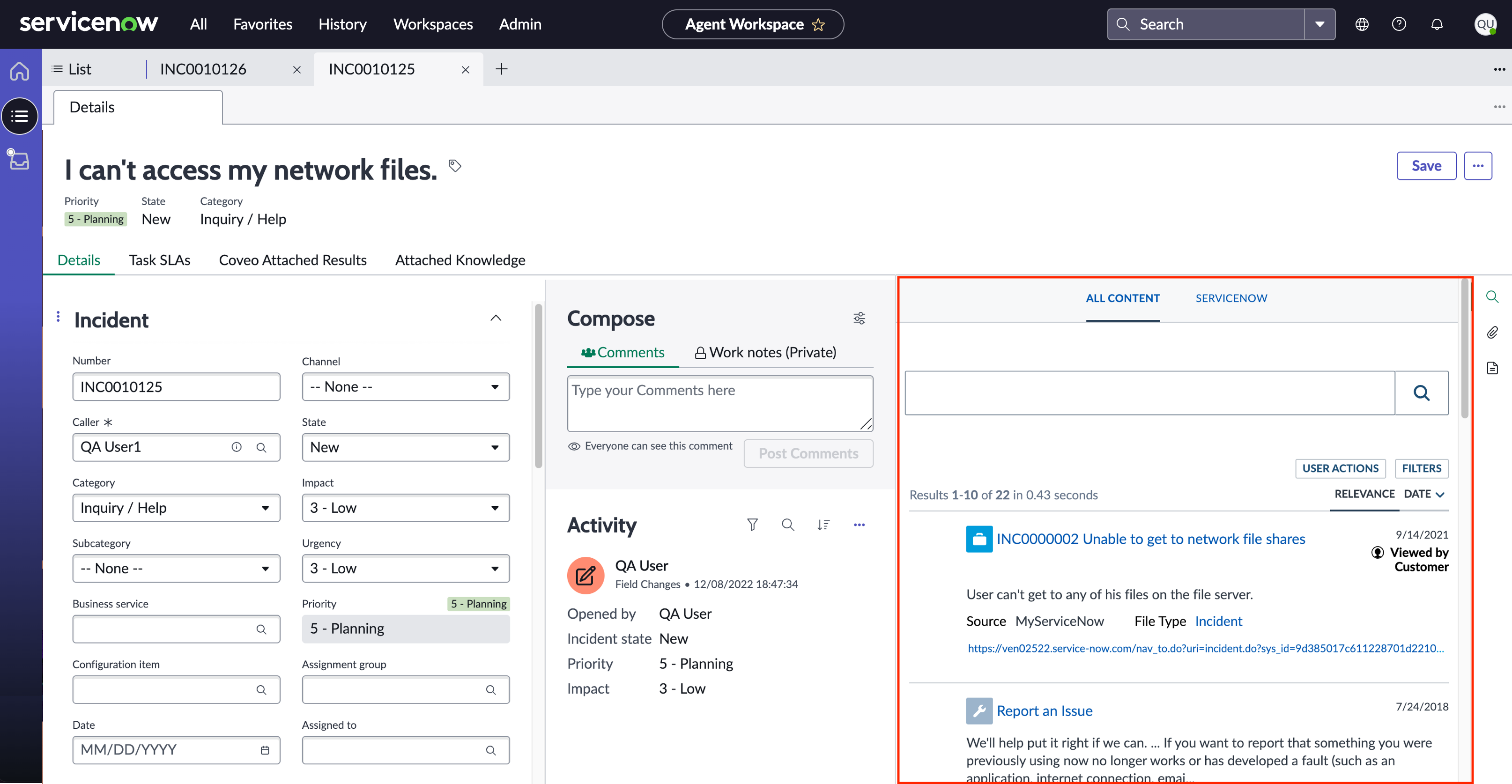
After all, the last thing your employees need is yet another digital workplace solution in their daily routine. Workplace search and discovery should exist in the form of components flexibly deployed across your employee experience. That means integrated within your existing intranet platform, employee self-service portals, or departmental knowledge bases to provide a modern and intelligent experience.
Does it Really Matter Where Your Enterprise Search Tools are Deployed?
It matters if you currently have an intranet platform or a self-service portal that isn’t as effective as you want it to be.
The problem with traditional intranet platforms? Employees don’t trust them because they typically contain incomplete or outdated information, leading them on a wild goose chase.
Instead of overhauling your tech stack and introducing yet another new tool for your employees, you can simply upgrade the search component and “quietly” transform the employee experience. This will turn your intranet or HR portal into a trusted knowledge hub that actually helps employees become more proficient in their roles.
The best part is that you can achieve this without performing risky migrations or requiring costly platform maintenance. You simply index what you want to make discoverable, and machine learning keeps the experience relevant to each person by learning from every interaction.
Dell is an example of a company that was able to break the cycle of constantly upgrading their intranet platform Inside Dell by combining their intranet and workplace search initiatives. After implementing Coveo, Dell saw employee satisfaction (ESAT) scores climb from 23% to over 60%.
Flexible deployment also keeps your business agile for the future. Let’s say you want to upgrade your intranet platform in a few years, or merge two departmental knowledge bases. You can rest assured that your workplace search solution will fit reliably into any of these plans.
5. Knowledge at Every Employee Touchpoint
Imagine going a step further and bringing that unified search experience into the tools your employees are actually working in. The best enterprise search solution makes this possible.
The ultimate employee knowledge experience — one which almost completely eradicates the effort from searching — is to be served relevant enterprise-wide content within the flow of work. That means bringing the search experience within applications like Google Workspace, Confluence, and Jira, via an “in-product” deployment.
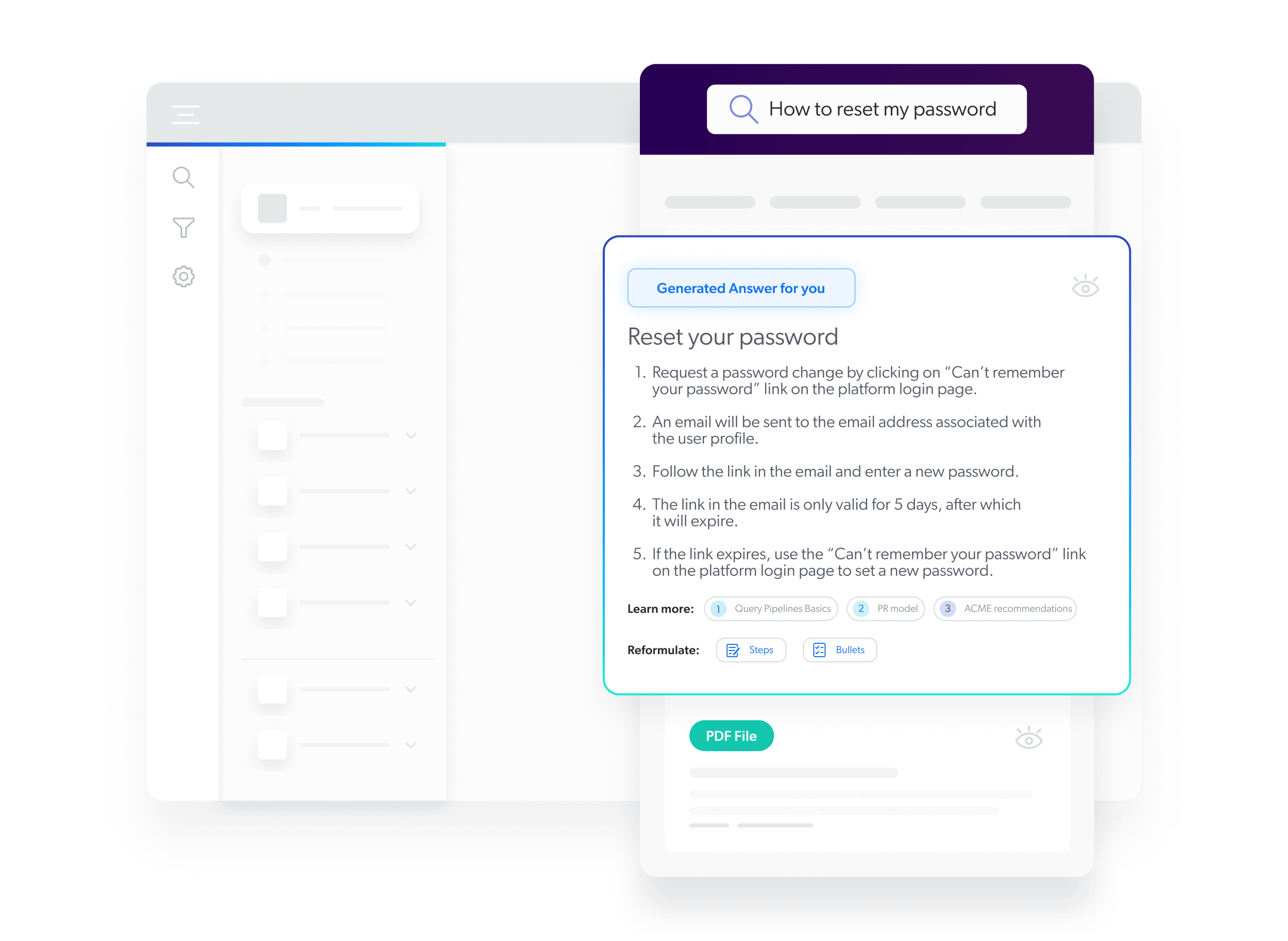
This not only saves employees time, but it also preserves focus and maintains a productive flow state. It allows them to get needed information without navigating away from the task at hand.
Coveo’s Slack connector is an example of this functionality in the digital workplace. Proactive content recommendations adapt to the application the employee is using, and the project they’re working on, leading to powerful and rewarding “in the moment” relevance.
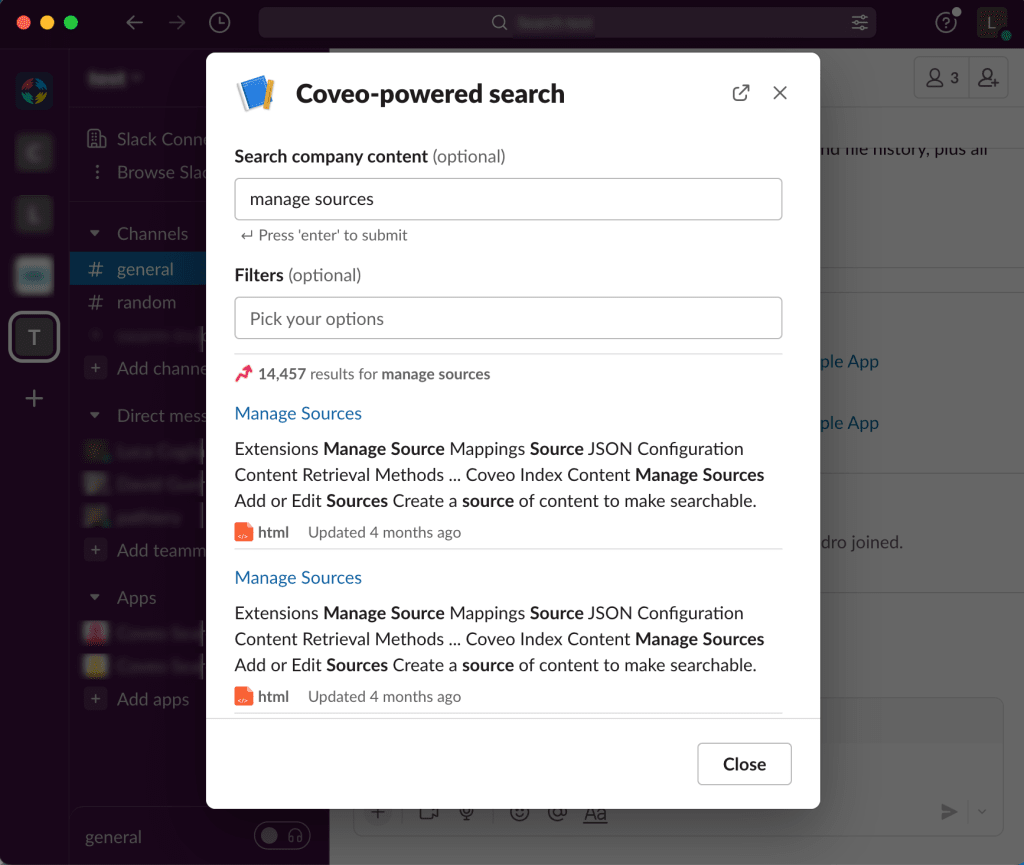
How Important is Content Discovery at Every Touchpoint?
Most enterprises want to create a better search experience within their intranets and portals by centralizing their knowledge. If you can successfully apply enterprise search to this use case, you’ll reduce information overload and empower teams to do their best work.
But for a next-generation employee experience, delivering proactive content recommendations right across the employee journey is valuable. This is the power of the Coveo Platform™: it minimizes distractions, supports employees at their exact moment of need, and shows an understanding of their daily work flow and what would improve it.
Manulife implemented Coveo AI-powered search to help employees find knowledge faster. Today, the system handles 65,000 average monthly searches, 70% of which are guided by AI-driven suggestions.
6. Actionable Insights for a Better Employee Experience
One of the biggest challenges of transitioning to remote and hybrid work has been retaining the human experience in the workplace.
Onboarding, in particular, is a sensitive stage of the employee journey that is tougher to accomplish well for a distributed company. Without the tour of the office, meeting coworkers face-to-face, and going for lunch, companies have to innovate to make their new employees feel welcome.
An enterprise search solution with powerful analytics provides new insight into what your employees need most and how to incorporate those insights into your onboarding, upskilling, and training strategies. You also learn to identify the moments that matter for your employees and use them to create more human experiences.
Relevant Reading: Coveo for Employee Experience Overview
For example, let’s say you put together a three-day onboarding program that accommodates on-site and remote employees. You might discover after running the session that there’s a spike in certain questions or topics being searched on your intranet platform. This shows you what matters to your employees at that stage of their journey, and allows you to improve your onboarding process by including those topics.
Senior managers and team leads can also use analytics to discover knowledge gaps that might be slowing down or frustrating members of their team. Plugging these content gaps on your company knowledge base, and covering them in team meetings, helps your employees to feel empowered and understood.
7. Commitment to Future Innovation
Businesses have discovered over the past couple of years how important it is to take a long-term view of technology and infrastructure. Can your current enterprise search platform help you navigate business pivots, market turbulence, mergers and acquisitions? And will your present search vendor act as a partner that’s also committed to innovation and growth?
Awards and industry recognition provide no guarantee, but they do provide important benchmarks in a crowded search marketplace. Recently, Coveo was named a Leader in the 2024 Gartner® Magic Quadrant™ for Search and Product Discovery. Notable here is that, of all the 18 companies evaluated, including Google and Sitecore, Coveo has the highest overall completeness of vision and ability to execute.
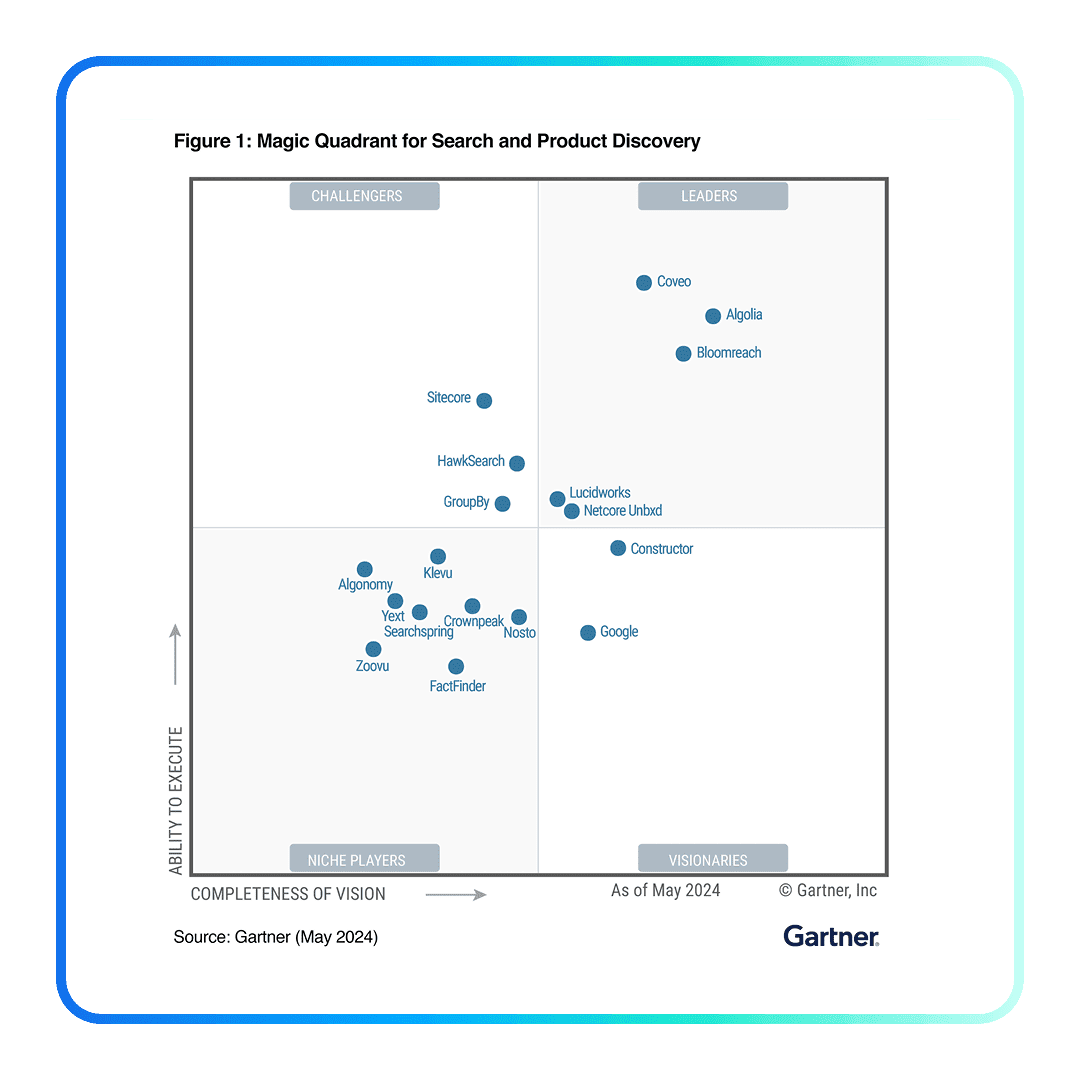
Workplace search has been at the heart of Coveo’s strategy since the company was founded in 2005, and with strong collaboration within the scientific community there are clear signs that the company is continuing to invest in search innovation.
Building a Case for Workplace Search
To dig deeper for the right workplace search solution, you’ll want to establish the business value of the modern search experiences and AI-driven personalization we’ve discussed in this article.
Case studies ought to be part of this evaluation. Look for:
- Like companies and deployments
- Desired business outcomes
- Tangible, quantitative return on investment
- Time to value
Our business value team has recorded a webinar in which they walk you through the measurable benefits of investing in intelligent digital employee experiences. You’ll discover some of the tangible benefits that AI-powered search has had for leading organizations like Adobe, and the types of business outcomes you can achieve by creating a more relevant workplace for your employees.
Relevant Viewing: Building A Solid Business Case for your Workplace Experience
Finding the Best Enterprise Search Software
Identifying the best enterprise search software is just the first part of building a comprehensive and connected employee experience. For insights on going beyond the search box, download our ebook on How ITSM Leaders Transform Employee Experience Using AI.

